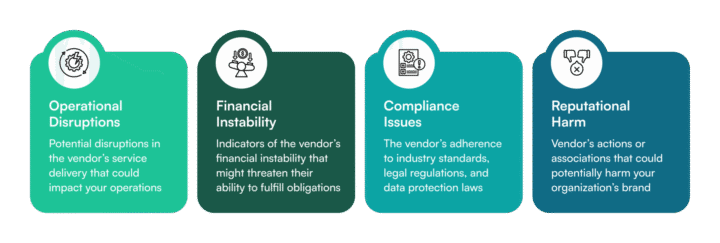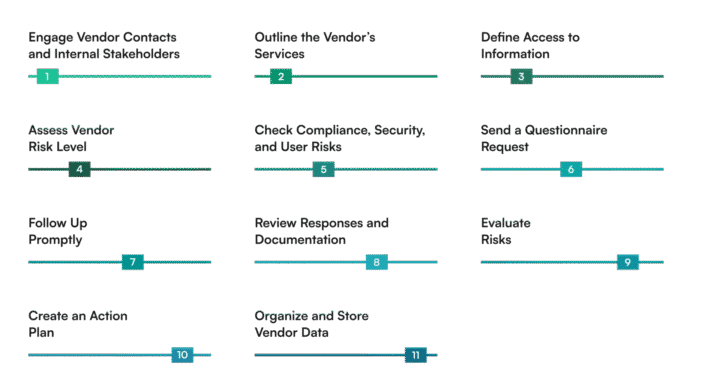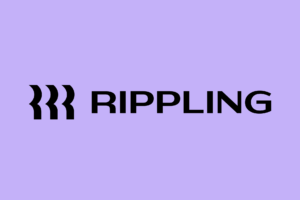GEOR manages the complexities of global workforce operations. In this article, we share a complete guide and checklist for vendor due diligence (VDD), a topic that has many organizations on high alert.
If you’re curious about how we handle risk management, scroll down to explore our services. If you are new to this topic, keep reading to gain valuable insights.
What is Vendor Due Diligence?
Vendor due diligence is a process designed for companies to evaluate potential partnerships and acquisition targets. A strategic VDD incorporates a comprehensive analysis of a prospect’s financial stability, compliance standards, and operational capabilities. Vendor due diligence empowers informed decision-making, ensuring collaboration with partners who align with your organization’s goals and vision.
The Importance of Vendor Due Diligence
Vendor due diligence is crucial in assessing risks and preventing disruptions in partnerships and acquisitions. In software development industry and global consulting, due diligence in IT services and global consulting services are essential to safeguard sensitive information and ensure regulatory compliance. Effective due diligence of suppliers helps prevent issues like data breaches, legal liabilities, financial instability, and reputational damage. A vendor check is needed, making responses faster and more effective, contributing to the overall company’s resilience.
The financial impact of poor vendor selection can be substantial. Our research indicates that companies conducting thorough due diligence are 35% less likely to experience major service disruptions. We’ve observed that systematic vendor evaluation directly correlates with improved operational stability.

Critical Risk Categories to Address During Supplier Due Diligence
Vendor due diligence identifies key risks, including:
- Operational Disruptions: potential disruptions in the vendor’s service delivery that could impact your operations.
- Financial Instability: indicators of the vendor’s financial instability that might threaten their ability to fulfill obligations.
- Compliance Issues: the vendor’s adherence to industry standards, legal regulations, and data protection laws.
- Reputational Harm: vendor’s actions or associations that could potentially harm your organization’s brand.

The Importance of Timely Reviews
As vendors grow and adapt, their safety profiles can change, which makes ongoing assessments crucial in keeping your company secure and compliant. Regular reviews are crucial for maintaining a proactive risk management strategy and ensuring continuous compliance with industry standards.
The Vendor Due Diligence Process
An efficient vendor due diligence process always starts with gathering the right information directly from a potential partner. You can collect essential documents such as financial statements, certifications, legal compliance records, and business continuity plans. This data lays the groundwork for evaluating a vendor’s stability and integrity. Another approach is to use questionnaires to assess the vendor’s financial health, verify compliance, and evaluate their data security. Ensuring your partners meet legal and operational standards protects your business and builds stronger vendor relationships, preventing disruptions.
Key Steps in Vendor Management Due Diligence
Follow this action plan to build a structured VDD strategy:
- Engage Vendor Contacts and Internal Stakeholders
Start by looping in the right internal teams – IT, finance, legal. Their perspectives are crucial for a well-rounded assessment.
- Outline the Vendor’s Services
Clearly lay out what the vendor offers. This sets a solid baseline for your evaluation.
- Define Access to Information
Identify the specific data or systems the vendor will access, as this is key to understanding the risk landscape.
- Assess Vendor Risk Level
Gauge the level of risk the vendor poses, considering their track record and standing in the industry.
- Check Compliance, Security, and User Risks
Ask targeted questions about the vendor’s compliance, data security practices, and any potential risks to users.
- Send a Questionnaire Request
Share a detailed questionnaire to gather the vendor’s information for your assessment.
- Follow Up Promptly
After sending the questionnaire, follow up to keep the process moving and ensure you get timely responses.
- Review Responses and Documentation
Dig into the vendor’s replies and documents to get a full picture of their risk profile.
- Evaluate Risks
Pinpoint the significance, impact, and likelihood of each risk to help prioritize your next steps.
- Create an Action Plan
Develop a clear action plan to tackle any risks and safeguard your organization.
- Organize and Store Vendor Data
Compile all vendor data in one place for easy reference during future evaluations.

What Information Should You Collect from Suppliers?
- Financial Health
Financial Statements: income statements, balance sheets, and cash flow statements (typically for the last 2 to 3 years).
Credit Reports: reports from credit rating agencies to assess creditworthiness.
Tax Returns: recent tax returns to verify income and compliance with tax obligations.
Revenue Projections: forecasts or business plans that detail expected revenue growth.
- Compliance Standards
Compliance Certificates: documentation proving adherence to industry standards (e.g., ISO, SOC 2).
Regulatory Filings: evidence of compliance with local and international regulations (e.g., SEC filings for public companies).
Licenses and Permits: copies of necessary licenses, permits, and certifications relevant to the vendor’s operations.
Audit Reports: reports from third-party audits to confirm compliance with regulatory requirements.
- Data Security
Data Protection Policies: documentation outlining data protection measures and practices.
Cybersecurity Protocols: evidence of security measures in place (e.g., firewalls, encryption, and intrusion detection systems).
Incident Response Plans: plans detailing procedures for responding to data breaches or security incidents.
Third-Party Security Assessments: results from any recent security assessments conducted by external auditors.
- Operational Reliability
Service Level Agreements (SLAs): contracts outlining performance expectations and metrics.
Quality Assurance Documents: processes and policies related to quality control and assurance.
Performance Metrics: reports or dashboards showing key performance indicators (KPIs) related to service delivery.
Backup and Disaster Recovery Plans: documentation of plans to maintain operations during disruptions.
- Reputation
Customer Testimonials and References: written feedback from existing or previous customers regarding their experience with the vendor.
Industry Reviews: articles or reports from industry publications that discuss the vendor’s performance and reputation.
Market Research Reports: studies that analyze the vendor’s standing within the industry and competitive landscape.
Social Media Feedback: reviews and ratings from social media platforms and review websites that provide insights into customer satisfaction.
Vendor Due Diligence Services & Solutions
Supplier due diligence is tedious. Requesting documents and having partners complete questionnaires can feel unglamorous. Outsource your vendor due diligence to experts and focus on your core priorities.
We offer Vendor Due Diligence Consulting
At GEOR, we take a proactive approach to supplier audits. Choose our vendor due diligence services for specialized and scalable support. Our approach is consistent, thorough, and aligned with industry standards, regardless of the complexity of your supply chain. Read more about GEOR’s vendor management solutions, protect your business and streamline your operations.
If you’re ready to elevate your vendor due diligence strategy, get in touch with us today.




